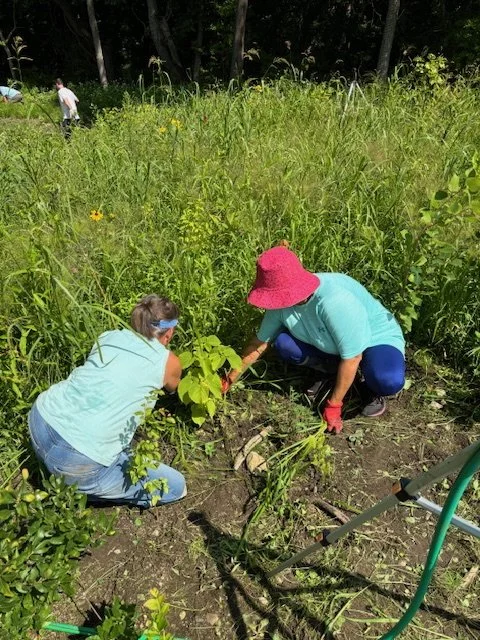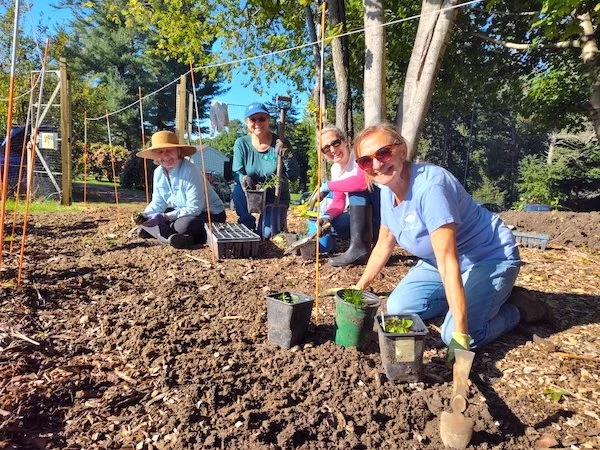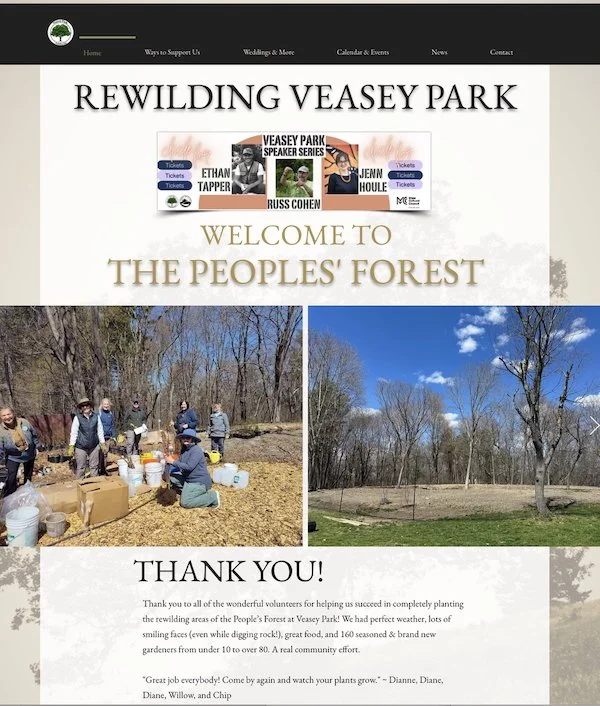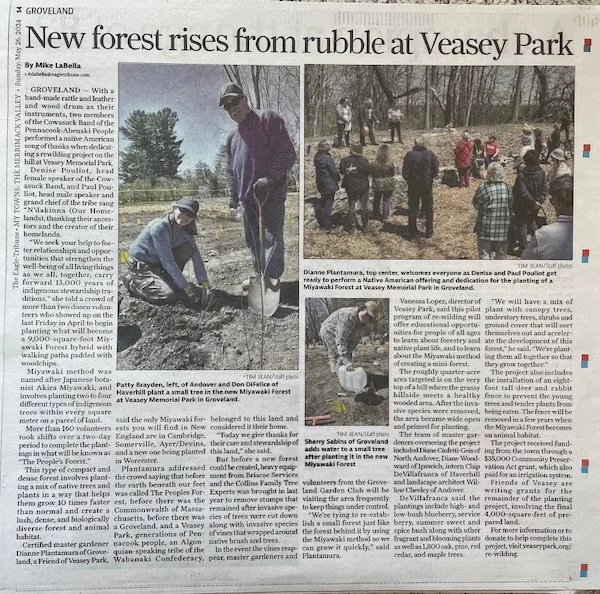Rewilding Conservation Land by Developing a Miyawaki Forest
Invasive shrubs and vines envelop much of our local forests, choking out native plants, trees and shrubs that are important for native wildlife.
At the hilltop of the 50 acres of Veasey Memorial Park in Groveland, 9000 square feet of the forest was identified as an invasive thicket.
The MA Master Gardener Association along with the Groveland Conservation Commission and the Management of Veasey Park presented a plan to the Town of Groveland for removal of the thicket and subsequent “rewilding” of the area.
Sometimes called “pocket forests,” Miyawaki forests grow 10x faster, are 30x denser, contain 100x more biodiversity and absorb 16x more carbon than conventionally planted forests. Since biodiversity is quick to establish, they’re self-sufficient after the first two-to-three years as a thriving ecosystem takes shape.
Groveland, MA
Veasey Memorial Park
Highlights
-
A 3-5 year Master Plan that is likely to change and develop over time.
Funding— this is not an inexpensive undertaking.
Communication across stakeholders.
Master Gardeners and a professional landscape architect, on the team.
Educating the community with signage and other materials.
-
The site was dedicated as “The People’s Forest” by leaders of the Abenaki Tribe. Newspaper coverage was excellent.
1500 trees were planted by 160 volunteers.
-
Native trees and shrubs and perennials: $7,011
Deer and rabbit fencing: $463
Irrigation contract and materials: $4730
Bulk compost/loam mix: $1843
Contractors to clear and dispose of invasives and to spread compost: $10,800
Materials to train community volunteers: $300
Water to irrigate (three years): $5,000
BioStimulent Treatment for new trees: $637
Marketing/signage: $1000
Lunches for prison detail: $250
In-kind support from the Groveland Garden Club, prison detail, Landscape Architect, neighbors with tractors
-
Town of Groveland Community Preservation Fund awarded the project $35,000.
Additional support was provided with grants from the MA Master Gardeners, New England Biolabs, the Groveland Garden Club and also by private donations.
The Friends of Veasey Park was the recipient of smaller donations. They are a 501(c)(3) organization.
-
For more information visit veaseypark.org/contact where you can submit a form
Steps to implement
Research the Miyawaki Method: read and study “Mini-Forest Revolution, Using the Miyawaki Method to Rapidly Rewild the World” by Hannah Lewis, attend presentations from Hannah Lewis and Biodiversity for a Livable Climate (Bio4Climate) about the Miyawaki Method, become a follower of SUGi, (international Miyawaki forest organization) assist at other Miyawaki forest makings in the area.
Write a 3-year Plan/Mission Statement to include all aspects of the project. The 3-year plan includes all relevant research, a timeline, suggested native plantings, prospective partners and specific information about the site to be developed. One important partner was the MA Master Gardener Association who supported the many MG volunteers who worked on the site. The MMGA had previously approved Veasey park as a Project Garden (for its native perennial bed plantings). The MMGA extended the project to be part of developing a Miyawaki forest.
Propose the project to funding sources. In the Veasey Park Rewilding plan, I presented the project in writing and in person to the Conservation Commission (ConComm) who oversees the site in question. The proposal included information about the benefits of native trees and biodiversity. ConCom then presented the project to the Community Preservation Committee (CPC) for approval.
Secure funding. The CPC presented the project at Town Meeting for approval. Many supporters had been asked to speak in favor of the project, which also included other tree work in Town. The proposal passed: to use one hundred thousand dollars for trees in Groveland (the Town was named Groveland in 1860 because of its trees). $35,000 of the $100,000 was designated seed money for the rewilding at Veasey Park.
Designate the exact area of the site to be cleared. In conjunction with ConComm, the area was marked with barrier tape. The site for the Veasey Park Miyawaki forest is located at the top of Veasey hill and surrounded on two sides by undisturbed forest and on two sides by grass. It was very difficult to mark the perimeter because the area was uneven and virtually impenetrable with invasive vines and shrubs.
Clear the site. Once the funds were released, a contractor was hired to clear the designated 9000 square foot site. Over a few days, six dump truck loads of invasive vines were removed and the site exposed two giant endangered American Elm trees that were wrapped in bittersweet vines. The site also exposed a stone 3 foot high by 100-foot-long containment wall. We believe it was used to hold back the hillside for farm equipment to be parked above the hill.
Examine and develop the site to best suit the natural lay of the land. In our case, the “wall” allowed us to create a perfect amphitheater in front of it, so that we could use it for educational purposes. The amphitheater area would be reached by two paths of wood chips that would begin at each opposite end of the site and converge at the amphitheater.
Develop a web page that would link into the Veasey Park primary page. The web developer of Veasey Park was excited about the project and agreed to work with us. At first there was related research about the benefit of a native planted forest, and as the project expanded, photos and a call for volunteers were placed on the page. See Rewilding Vease Park for a history of the project, press, and hundreds of photos taken during planting days.
Meet regularly with the designated Team to develop a plan according to the Miyawaki method of tree planting. We met twice a month for 6 months to make decisions about the varying percentages of climax, sub-climax, and shrubs that are prescribed in “Mini-forest Revolution.” The book was used as a manual. Native trees of northeastern MA were chosen and amounts designated. Orders for over 1500 trees and shrubs were placed with primarily bare root nurseries.
Design and plan for planting days. We chose two consecutive dates at the end of April 2024 and arranged for delivery of plants during the days before planting. The Team met every day prior to planting to map out exactly how the planting would go. One Team member wrote plans to “train the trainer.” Because the Project had been approved as a Project Garden by the Master Gardener Association, we were able to secure many Master Gardeners to lead the groups of volunteers. Volunteers were recruited from community members, scout troops, garden clubs and friends. There were 160 volunteers who signed up over the two days.
Reach out to the local press and develop a dedication to take place during the planting days. The press arrived, took photos and wrote a powerful piece for the Eagle Tribune. See photo of the press article. In addition, I spoke about the need for the rewilding and two members of the Cowasuck Band of the Pennacook-Abenaki People dedicated the site, performed a native American song of thanks and spoke eloquently about the need for all people to care for the land.
Ensure optimum growth of trees. The SavATree organization came twice at one month intervals to spray the planted area with Arborkelp Biostimulant treatment.
Maintenance of plants. Twice a month, Master Gardeners and Groveland Garden Club members volunteered to weed and check tree growth. Weed growth was excessive, and a prison detail was brought in a few times to assist.
Continue press coverage. At every opportunity, give interviews to local press and the Master Gardener organization. See the MMGA newsletter The Dirt, January 2025 and The Town Common (servicing north shore of MA), https://thetowncommon.com/2025/03/05/plant-matters-2/
Making it Great!
-

What worked well
Regular attention to detail!
-

What worked less well
Unanticipated results, e.g. weeds that grew taller than the little trees!
-

Advice
Funding is critical for success, and a dedicated team.
Additional Resources
-

Plant Matters from the Town Common News
Learn about the Miyawaki method and how it was implemented in Groveland.
-

Website for Rewinding Veasey Park
The rewilding Veasey Park website shares photos of the work in progress.
-

Eagle Tribune Article
If you have an Eagle Tribune subscription you can read New forest rises from rubble at Veasey Park online.

